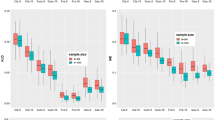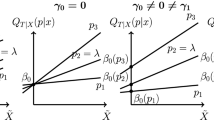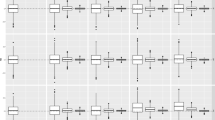Abstract
The use of bivariate distributions plays a fundamental role in survival and reliability studies. In this paper, we consider a location scale model for bivariate survival times based on the proposal of a copula to model the dependence of bivariate survival data. For the proposed model, we consider inferential procedures based on maximum likelihood. Gains in efficiency from bivariate models are also examined in the censored data setting. For different parameter settings, sample sizes and censoring percentages, various simulation studies are performed and compared to the performance of the bivariate regression model for matched paired survival data. Sensitivity analysis methods such as local and total influence are presented and derived under three perturbation schemes. The martingale marginal and the deviance marginal residual measures are used to check the adequacy of the model. Furthermore, we propose a new measure which we call modified deviance component residual. The methodology in the paper is illustrated on a lifetime data set for kidney patients.
Similar content being viewed by others
References
Carrasco JMF, Ortega EMM, Paula GA (2008) Log-modified Weibull regression models with censored data: sensitivity and residual analysis. Comput Stat Data Anal 52: 4021–4029
Clayton DG (1978) A model for association in bivariate life-tables and its application in epidemiological studies of familial tendency in chronic disease incidence. Biometrika 65: 141–151
Collett D (2003) Modelling survival data in medical research. Chapman & Hall, London
Conway DA (1979) Farlie–Gumbel–Morgenstern distributions. In: Kotz S, Johnson NL (eds) Encyclopedia of statistical sciences, vol 3. Wiley, New York, pp 28–31
Cook RD (1986) Assessment of local influence (with discussion). J R Stat Soc B 48: 133–169
Cox DR, Hinkley DV (1974) Theorical statistics. Chapman and Hall, London
Cox DR, Oakes D (1984) Analysis of survival data. Chapman and Hall, New York
Cox DR, Snell EJ (1968) A general definition of residuals. J R Stat Soc B 30: 248–275
Doornik J (2001) Ox: an object-oriented matrix programming language. International Thomson Bussiness Press, UK
Embrechts P, Linskog F, McNiel A (2003) Modelling dependence with copulas and applications to risks management. http://www.math.ethz.ch/baltes/ftp/papers.html
Escobar LA, Meeker WQ (1992) Assessing influence in regression analysis with censored data. Biometrics 48: 507–528
Fachini JB, Ortega EMM, Louzada-Neto F (2008) Influence diagnostics for polyhazard models in the presence of covariates. Stat Methods Appl 17: 413–433
Galea M, Riquelme M, Paula GA (2000) Diagnostics methods in elliptical linear regression models. Braz J Probab Stat 14: 167–184
Gustafson P, Aeschliman D, Levy AR (2003) A simple approach to fitting Bayesian survival models. Lifetime Data Anal 9: 5–19
He W, Lawless JF (2005) Bivariate location-scale models for regression analysis, with applications to lifetime data. J R Stat Soc 67: 63–78
Hougaard P (1986) A class of multivariate failure time distributions. Biometrika 73: 671–678
Hougaard P (1989) Fitting a multivariate failure time distribution. IEEE Trans Reliab 38: 444–448
Jin Z, Lin DY, Wei LJ, Ying Z (2003) Rank-based inference for the accelerated failure time model. Biometrika 90: 341–353
Klein JP, Moeschberger ML (1997) Survival analysis: techniques for censored and truncated data. Springer, New York
Lawless JF (2003) Statistical models and methods for lifetime data. Wiley, New York
Lesaffre E, Verbeke G (1998) Local influence in linear mixed models. Biometrics 54: 570–582
McCullagh P, Nelder JA (1989) Generalized linear models, 2nd edn. Chapman and Hall, London
McGilchrist CA, Aisbett CW (1991) Regression with frailty is survival analysis. Biometrics 47: 461–466
Nelsen R (1999) An introduction to copulas. Springer, New York
Oakes D (1989) Bivariate survival models induced by frailties. J Am Stat Assoc 84: 487–493
Ortega EMM, Bolfarine H, Paula GA (2003) Influence diagnostics in generalized log-gamma regression models. Comput Stat Data Anal 42: 165–186
Ortega EMM, Cancho VG, Bolfarine H (2006) Influence diagnostics in exponentiated—Weibull regression models with censored data. Stat Oper Res Trans 30: 172–192
Ortega EMM, Rizzato FB, Demétrio CGB (2008a) The generalized log-gamma mixture model with covariates: local influence and residual analysis. Stat Methods Appl. doi:10.1007/s10260-008-0104-x
Ortega EMM, Paula GA, Bolfarine H (2008b) Deviance resiadual in generalized log-gamma regression models. J Stat Comput Simul 78: 747–764
Ortega EMM, Paula GA, Bolfarine H (2009) Generalized log-gamma regression models with cure fraction. Lifetime Data Anal 15: 79–106
Paula GA (1993) Assessing local influence in restricted regression models. Comput Stat Data Anal 16: 63–79
Paula GA (1995) Influence and residuals in restricted generalized linear models. J Stat Comput Simul 51: 315–352
Pettitt AN, Bin Daud I (1989) Case-weight measures of influence for proportional hazards regression. Appl Stat 38: 51–67
Romeo JSN, Tanaka NI, Pedroso de Lima AC (2006) Bivariate survival modeling: a Bayesian approach based on Copulas. Lifetime Data Anal 12: 205–222
Sahu SK, Dey DK (2000) A comparison of frailty and other models for bivariate survival data. Lifetime Data Anal 6: 207–228
Shih JH, Louis TA (1995) Inferences on the association parameter in copula models for bivariate survival data. Biometrics 51: 1384–1399
Silva GO, Ortega EMM, Cancho VG, Barreto ML (2008) Log-Burr XII regression models with censored data. Comput Stat Data Anal 52: 3820–3842
Vaupel JW, Manton KG, Stallard E (1979) The impact of heterogeneity in individual frailty on the dynamics of mortality. Demography 16: 439–454
Author information
Authors and Affiliations
Corresponding author
Rights and permissions
About this article
Cite this article
Barriga, G.D.C., Louzada-Neto, F., Ortega, E.M.M. et al. A bivariate regression model for matched paired survival data: local influence and residual analysis. Stat Methods Appl 19, 477–495 (2010). https://doi.org/10.1007/s10260-010-0140-1
Accepted:
Published:
Issue Date:
DOI: https://doi.org/10.1007/s10260-010-0140-1




